
The Natural Georgia Series: The Chattahoochee River

 |
The Natural Georgia Series: The Chattahoochee River |
 |
 Flora
and Fauna of the Chattahoochee River
Flora
and Fauna of the Chattahoochee River The Chattahoochee River begins as a bubbling spring in the North Georgia mountains. The headwaters, which begin at the base of the Appalachian Trail, carry the river through the Chattahoochee National Forest. From there the river flows south and west through Atlanta. When it reaches the Alabama state line, it flows south until it merges with the Flint River. Those two rivers eventually form the Apalachicola, which dumps into the Apalachicola Bay in the Gulf.
When the Chattahoochee first formed, it was a warm-water stream for much of its length, incapable of sustaining trout below the Blue Ridge mountains. The completion of the Buford Dam in 1956 forever changed the river, however.
The most notable change was the establishment of the Chattahoochee as a cold-water stream south of the dam. The dam, which pulls water out of Lake Lanier, releases cold water. With that change, many species of wildlife could no longer survive there. In their place, animals that could adapt to the colder temperatures have flourished.
Animals affected by the dam construction included a number of fish and freshwater mollusks, just to name a few. The nine dams along the course of the river have destroyed the habitat needed for these species' survival because the impounded areas are not suitable for habitat by organisms that require flowing water and because the cold water releases are not conducive to a diversity of organisms.
The Chattahoochee, as it winds through numerous habitats and regions of Georgia has become, in a sense, a highway that wildlife use for travel. The river corridor also provides wildlife access to drinking water, sites for nests and dens, and berry-producing shrubs along its banks as a source of food. The river serves as a permanent home to creatures that spend nearly all their time in the river's waters and draws in an array of terrestrial animals that visit regularly for a variety of needs including food, shelter, and water.
 Bald
Eagle
Bald
Eagle Less than 20 years ago, the bald eagle (Haliaeetus leucocephalus) was nearly extirpated from Georgia, a victim of DDT poisoning, a pesticide that weakened the shells of bird's eggs causing death to the unborn chicks. Today's bald eagle population is rebounding in Georgia due to an extensive restoration program by the Georgia Department of Natural Resources. The number of nests has been increasing each year, rising from no known nests in 1979 to 49 in 1999 (an increase of 12 from 1998). From 35 of these nests, a total of 53 young were produced. Several of this past year's nests were located along the Chattahoochee River and its impoundments. Nests were confirmed in the following locations: the backwaters of West Point Lake, Goat Rock Lake, Fort Benning, Lake Eufaula, and a site just north of Blakely, Georgia on the river.
Bald eagles prefer nesting sites located near large bodies of water such
as lakes and rivers where they can easily find one of their favorite foods,
fish. Bald eagles are largely opportunistic and will prey on small
mammals like mice and shrews, small snakes, turtles, coots, amphibians,
and even carrion. The nest of a bald eagle is quite impressive. The male
and female build the structure with an assortment of sticks and other vegetation,
often near the top of a very tall tree to give them a good view of their
territory. The eagles, which mate for life, generally use the same nest
year after year. After years of adding on to the nest, it may be more than
30 feet wide and weigh more than a ton!
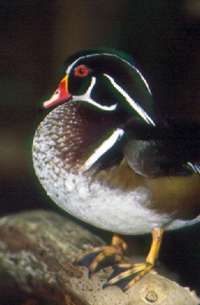 Wood
Duck
Wood
Duck A year-round resident of Georgia and much of the Southeast, the wood duck (Aix sponsa) brings a blaze of color to the Peach State's waters. One of the most brightly colored waterfowl in North America, the male wood duck proudly sports a rainbow iridescence of dark greens, browns, and blacks, which sharply contrasts with its pale white underside. Females are much duller in color but have a distinct white eye patch and the characteristic dark, crested head. In flight, wood ducks can be identified by their long, dark, square tail. They can be heard making a loud, distressed "whoo-eek" or a finch-like "jeee" with rising inflection. Wood ducks are common in wooded swamps, rivers, and ponds. They are unusual because they are comfortable on land, water or in the air. Their feet can propel them through the water, but are also equipped with claws that enable the ducks to perch on tree limbs. Their legs are farther forward on their body than other ducks allowing them to walk and run on land, and their beak is narrower than most ducks enabling them to pick acorns and nuts off the ground.
Wood ducks nest in tree cavities, usually more than 30 feet off the ground. They are primarily surface feeders, eating a variety of aquatic plants, small aquatic animals, and insects; however, they will occasionally feed on land on seeds and grasses.
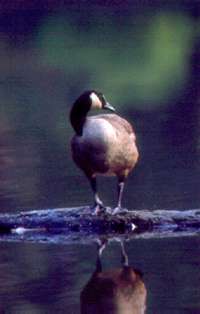 Canada
Goose
Canada
Goose The Branta canadensis, or Canada goose, is the most common goose in North America. A large waterfowl, the Canada goose is easily identified by its large size and its bold coloration of a black head and neck sharply contrasted by a white patch that runs from behind the eye to beneath the chin. This coloration is also evident on the tail, which has dark tail feathers on top and white underneath. The upper body is mostly brown in color shifting to a lighter tan on the underside.
These geese are also known for traveling in a "V" formation. The flocks are often noisy in flight and have the characteristic "honk" call. The Canada goose is more terrestrial than ducks, and spends a lot of time grazing on land. It will feed on grasses, seeds, and aquatic plants. The Canada goose was once rare in Georgia, but through a stocking program, its numbers have been restored. The strong population is most evident in parks near the Chattahoochee River where scores of geese can be seen on a daily basis grazing on the riverbanks and accepting handouts from park visitors. Large numbers of geese can become pests to landowners by leaving piles of unwanted scat in their yards.
The belted kingfisher is one of nature's greatest spectacles when it dives headfirst to retrieve its prey. A small bird ranging only 11-14 inches high, the kingfisher (Megaceryle alcyon) is a fish-eater and hunts its prey from perches above the water where its keen eyesight allows it to locate fish. The bird may perch on a branch or hover above the water by rapidly beating its wings, before making the plunge underwater to grab its meal.
These solitary birds have oversized heads and necks to absorb the shock of hitting the water headfirst and sharp, heron-like bills to spear the slippery fish. The kingfisher has blue-gray feathers with light gray on its breast and belly and a broad gray band across its neck. (Females often have a second rust-colored band the across breast.) It also bears its characteristic ragged, bushy crest on the top of its head. Its call sounds like a loud, dry rattle. Kingfishers will dig nests in the high sandy banks of a stream or lake. The nest is usually a 3- to 7-foot-long tunnel with a nesting area at the end. They swallow their fish whole, usually from a perch in a tree.
Perhaps one of nature's most skilled engineers is the beaver (Castor canadensis), capable of damming entire streams and building lodges that stretch as far as 39 feet across and over 6 feet high. These talented aquatic mammals are equipped with two very large front teeth that are reddish-orange in color and grow throughout their life. With these teeth, beavers can fell the trees needed for their construction work. They are so adept that it takes only 3 minutes to fell a willow 5 inches thick! The trees it takes down are gnawed into pieces it can carry back to the lodge where it will eat the bark or store it for the winter. The aquatic creatures are America's largest rodent, averaging 3 to 4 feet long and weighing 44 to 60 pounds. They look anything like a rat despite their dark brown fur and tiny ears, thanks to their webbed hindfeet and their broad, flat tail that extends 12-16 inches from their body. When alarmed the beaver uses its black, scaly tail slapping it on the water to produce a loud noise to scare off predators or alarm other beavers of danger.
Beavers are good swimmers traveling up to 6 mph. Adult beavers can stay submerged for 15 minutes at a time. When submerged, valves close off ears and nostrils and a skin flap seals the mouth so that exposed teeth can carry logs underwater. Beavers are nocturnal creatures that feed on bark, twigs, and leaves. They use their lodges built of twigs, logs, and mud for protection during the day. Even the entrance to the lodge is underwater for added security from predators. During the winter, beavers will store limbs inside the den for food. Beavers are generally monogamous and have a typical litter of four to five young or kits. The young are born with fur and open eyes and can swim within one week. Beavers are considered pests by some landowners because of their persistence in damming up flowing water and felling trees.
 Great
Blue Heron
Great
Blue Heron Because of its immense size and elongated form, the great blue heron has an almost prehistoric appearance to it. The Ardea herodias is a tall, slender gray bird that stands up to 4 feet tall and has a very long beak, legs, and necks. It is commonly seen in the shallow waters of a marsh, pond, or tideflat, standing so still that it is easy to overlook. Its long, stick-like legs are very useful for wading through shallow water as the bird looks for its prey. With incredibly keen eyesight, the heron is able to detect movement in even the deepest shadows and can strike quickly and accurately with its dagger-like beak. The great blue heron is beautifully colored with white around the head and light gray elsewhere. Its long neck may be stretched out to full length or folded in an "S" shape as is common when the bird takes flight. It feeds on a host of fish, frogs, crawfish, mice, and insects. Its call is a deep, harsh croak of "frahnk, frahnk, frahnk."
Also of the rodent family, Ondatra zibethicus is active primarily at night, but may be seen at any time of the day. Muskrats are excellent swimmers and spend most of their time in the water, propelled by slightly webbed hindfeet and steered by their long, slender tail. They too can remain submerged for as long as 15 minutes.
The muskrat has a dark, glossy brown color on the back, which lightens into a tan color on the sides before evening out at light beige on the underside.
Muskrats build large lodges somewhat similar to those of the beaver except that muskrat lodges consist primarily of aquatic plants, especially cattails, and are built on a platform of mud and other vegetation. The lodges are usually located in marshy areas or along riverbanks. The dens commonly have one nesting chamber with one or more underwater entrances; however, lodges along banks are often more elaborate with two or more rooms, each with one or more tunnels leading underwater.
Females produce one to five litters per year of 1 to 11 young (usually 4 to 7). The young are born naked, but develop fur after two weeks and can then swim. They stay with their mother for only one month before taking off on their own.
Muskrats primarily eat vegetation like cattails, sedges, and water lilies. In some cases, they may eat freshwater clams, frogs, crayfish, and fish. Their primary predators are raccoons and mink, which prey on the young.
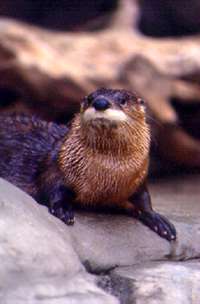 River
Otter
River
Otter One of the river's most adorable creatures is the river otter or Lutra canadensis. Averaging 3-4 feet long including its long, slender tail, these furry river-dwellers are fun to watch as they frolic in the water, amusing themselves by sliding, diving, or riding along on a rapid current. Unlike the beaver and muskrat, river otters are active during the day. They are fast, graceful swimmers both underwater and on the surface, in addition to being able to run well on land. River otters are found in wetland habitats in lakes, rivers, and ponds, usually in areas that back up to woodlands or have some dense cover. River otters have a blunt whiskered nose, short forearms, and partially webbed hindfeet. They are rather small, weighing from 11 to 30 pounds. They are kept insulated with their brown fur, which becomes paler on the underside of the snout and body.
River otter dens are often dug into the banks and have both underwater and visible entrances. The nests consist of sticks, grass, reeds, and leaves. River otters are carnivores and feed mainly on fish, though they will also prey on small mammals like mice and terrestrial invertebrates. Otters will sometimes work together to drive a school of fish into an inlet where they can catch them more easily. They eat small catches in the water while floating on their back. They have anywhere from one to six (though usually only two to four) young born at a time.
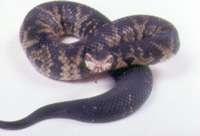 Cottonmouth
Cottonmouth
Three subspecies of cottonmouths are found in North America. Only two of these, the Eastern and Florida species occur in Georgia. The Eastern species occurs in central and north Georgia, while the Florida species is limited to south Georgia.
The cottonmouth (Agkistrodon piscivorus), also known as the water moccasin, is a dark, heavy-bodied, venomous water snake that ranges in size from 20-74 inches. It has a broad head that noticeably widens at the neck. It may occur as olive, brown, or black on the topside and may be patterned. It may also have a wide, light-bordered, dark-brown stripe across its cheek. Cottonmouths mate in the spring and fall, breeding live young. The young tend to be more distinctly patterned and bear bright yellow-tipped tails
The bite of a cottonmouth can be more serious than that of a copperhead and can be fatal if not properly treated. When threatened or disturbed, a cottonmouth may gape repeatedly at the intruder showing the light-colored "cotton" lining of its mouth. Unlike other water snakes, it swims with its head up out of the water. It may be seen basking during the day but is primarily active at night, feeding on frogs, fishes, snakes, and birds.
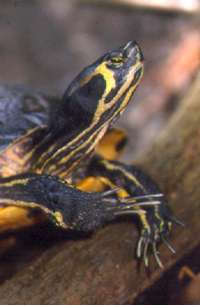 Pond
Slider
Pond
Slider Two subspecies of pond sliders, the red-eared and yellow-bellied, are found in Georgia. The water turtles can usually be spotted basking in the sunlight on an exposed log, sometimes stacked on top of one another. Sliders are identified by prominent yellow, orange, or red blotches or stripes behind their eyes. The yellow-bellied is accurately marked with a distinct yellow blotch behind the eye, in addition to yellow-colored bars on the scutes. The red-eared has a wide red stripe behind the eye.
Sliders have an oval-shaped carapace (or shell) that is olive to brown in color with a pattern ranging from yellow bars and stripes to reticulations and eyelike spots. Their plastron, or their underside, is either solid yellow or intricately patterned. With age, pattern and head blotch may become masked by black pigment, making identification difficult. Sliders (Chrysemys scripta) can be found in rivers, streams, swamps, and ponds. The turtles lay eggs in a nest cavity 1-4 inches deep, sometimes far from the water. Young sliders will feed on water insects, crustaceans, mollusks, and tadpoles; however, the turtles become more herbivorous as they mature. Pond sliders are also known as the "dime store" turtle because of the millions of these animals that have been reared on turtle farms and sold as pets.
 Largemouth
Bass
Largemouth
Bass One of the most common fish in the Southeast, the largemouth bass (Micropterus salmoides) is so named because of its very large mouth, the corners of which extend back pass the eye. Pale olive to silvery green in appearance, the fish has a thick lateral stripe, black to brown in color, which extends across the side of the fish to the tail. The stripe may be solid or a series of blotches. The coloration of the largemouth bass may differ depending on the water in which it lives. The darker the water, the darker shades of green the largemouth bass will be.
Largemouth bass are found in nearly all types of fresh water. Young bass will feed on small crustaceans and insects and their larvae. Adults are more opportunistic feeding on a wide range of small animals including frogs and snakes that make their way into the bass' territory; however, they primarily feed on fish, crayfish and large insects.
Male largemouths take most of the credit for reproduction. They start the process by building a nest, which is simply a depression along the stream bottom that they fan out using their fins. They will entice females to the nest and may spawn with more than one. The males will then guard the nests until the eggs hatch (usually two to four days), continually fanning the eggs to keep them free of silt. The males do not eat during this time period. When the small fish hatch, they form a school, and the male will guard them for another week. One of the most popular sport fish in North America, largemouth bass is a favorite of anglers.
 Mayfly
Mayfly
A small- to medium-sized insect found near water, the mayfly is an elongated insect with a very soft body and two or three very long, hair-like tails. The adults and nymphs are a very important food of freshwater fish found in the Chattahoochee River, especially trout. In fact, many fly fishermen tie flies that mimic the mayfly in order to catch rainbow and brown trout on the Chattahoochee.
The mayfly is a very important insect to the trout fishery of the Chattahoochee because its presence is a good indicator of water quality. Mayflies are very susceptible to changes in water quality such as temperature and pollution so healthy populations of mayflies are a good sign. Belonging to the order Ephemeroptera, the mayflies found on the Chattahoochee may be one of numerous species, so similar in appearance that the only distinguishing mark might be the number of tiny hairs found on the body.
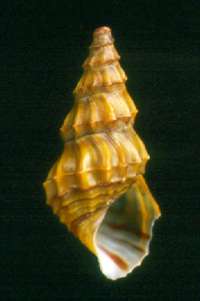 Flaxen
Elimia
Flaxen
Elimia Flaxen elimia (Elimia boykiniana) is a freshwater snail believed to be restricted to a single shoal in the Chattahoochee River. Isaac Lea first described this species from the Chattahoochee River in Muskogee County near Columbus in 1840. There were several collections of flaxen elimia in the 1950s and 60s, and then the snail was found in 1992 in Harris County, the only place it is believed to live today.
Over 500 species of freshwater snails (Gastropods) have been identified in North America. The southeastern U.S. is home to 60 percent of these. But river snails are rare in the Chattahoochee, primarily because of the dams along the river. In order to live, most species require flowing water, which dams prohibit. These animals are also susceptible to sedimentation because they are scrapers. They typically live on rocks, cobbles, and bedrock in shoal areas, but if there are sediments, the snails can't feed on rocks and have difficulty laying eggs. Some species have adapted to springs and small streams where they can feed on algae and other organic matter.
 Yellow
Perch
Yellow
Perch Yellow perch, or Perca flavescens, occurs in the pools of rivers such as Bull Sluice just south of Morgan Falls dam on the Chattahoochee where there is a good population of these fish. Dark green or black vertical bands stretch across the back and down the sides of this olive-green fish. A yellow-gold hue covers the belly and extends partially up the sides.
Normally found in large schools, the yellow perch spawn in the spring. Eggs are formed in gelatinous strings that are attached to vegetation. No parental care is provided.
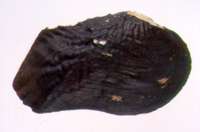
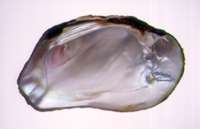 Purple
Bankclimber
Purple
Bankclimber In a recent survey on the Chattahoochee, only five species of mussels were found in the river's main channel. Historically, 30 were known to exist in the Chattahoochee. But because of damming along the river, poor land use practices, and pollution, the number of mussels has declined dramatically. One species that once lived in the Chattahoochee but has apparently been extirpated from the river is the purple bankclimber (Elliptoideus sloatianus). The second largest freshwater mussel in the Apalachicola-Chattahoochee-Flint basin, this species reaches lengths of 8 inches across. With a heavy brownish-black to black shell that is distinctly sculptured, its nacre is white in the center becoming deep purple near the edges and iridescent on its posterior. It feeds on plankton, bacteria, and algae filtered through the water, and may live for many years in good conditions. It is currently listed as threatened on the state and federal endangered species lists.
The Chattahoochee River offers an overwhelming diversity of plants and habitats along its path. Its headwaters begin in the rough terrain of the mountains where the stream is much narrower. The rich, mature growth surrounding this section of the river, particularly in the Chattahoochee National Forest, provides a haven for shade-loving plants such as algae, moss, and ferns.
As the headwaters pass through Helen, they enter the first impoundment found on the river: Lake Lanier. Here, the river takes on many of the characteristics of a freshwater pond in many ways, and plant life here is similar to that found around other Georgia lakes. As the stream continues to broaden and slow, plants along the edges and backwaters provide a growing place for algae, an important food source for tadpoles. Few plants can be found living along the shifting river bottoms but instead are found crowded around the riverbanks. Wetlands are formed along the river's path, creating yet another habitat. Here, the water levels fluctuate dramatically and regularly, demanding plants that can tolerate the rising and falling water levels.
From the beginning to the end of the Chattahoochee, the plant life consists of a rich array of plants that occur in the river and along its edge. The water's edge is typically the most richly inhabited, but the variety of plants depends on the elevation level, temperature, soil content, and other factors relative to the varying regions the river passes through.
If you've ever walked across slippery rocks in a stream, you have come into direct contact with one type of algae that thrives in fresh water. Diatoms are unicellular organisms that are important components of fresh water and marine phytoplankton and an important source of food for small marine animals such as insect larvae. Diatoms are characterized by fine, double, silicon-containing shells. In rivers like the Chattahoochee, algae often cling to rock surfaces. Organisms that live in the shallows of the river, such as the larvae of caddisflies, will feed on the algae, which is an important food source for them. Algae found in streams grow much faster than other forms of algae.
A 4- to 5-foot perennial that springs from creeping rootstocks, cattails are prolific in wetlands and marshes throughout the eastern half of the continent but are most common near the coast. The flower, or seedhead, of the cattail (Typha latifolia) is a soft and fuzzy slender cluster that is brown in color. It may be packed with as many as 250,000 seeds, which may be caught in the wind or carried off on the feet or fur of passing wildlife. Cattails also have off-shooting horizontal roots called rhizomes, which are a favorite food of muskrats. A family of muskrats can often be found in the vicinity of a large outcropping of cattails.
They provide cover for a host of wildlife such as marsh rabbits, Eastern cottontails and wild turkeys that hide in the cattails' shadow. They also provide nesting spots for a variety of waterfowl including coots and red-winged blackbirds.
A native to the shallow waters of marshes, ditches, and streams throughout Georgia, the pickerel weed (Pontederia cordata) is a colonizing aquatic herb. Its beautiful blue flowers are short-lived, occurring from summer to early autumn. The flowers are born in a congested, spike-like panicle on a stalk with one leaf and a bladeless sheath. The weed often grows at an angle, creating unusual textures when they accumulate in masses. Pickerel weed is one of the best and easiest aquatics to grow in shallow water.
The sweetgum (Liquidambar styraciflua) is so named for the sweet fragrance given off by its leaves when they are crushed. It also produces a sap that forms hardened clumps on the bark and was one of the earliest forms of chewing gum.
The sweetgum tree can be identified by its star-shaped leaves that are five- or seven-lobed. It has smooth twigs without rings, and its mature bark is gray in color. It is symmetric in shape, and the top of the tree is conical in shape or flat topped. The sweetgum's hanging seedballs are eaten by wildlife including songbirds, wild turkeys, chipmunks and squirrels A tall tree, the sweetgum reaches heights of 50-120 feet and 3 to 4 feet in diameter. It prefers wet habitats such as that of marshes. Sweetgum is sometimes used for furniture because its veneer has a nice shine or polish to it. The lumber is used for interiors, woodenware, boats, toys, boxes, and fuel.
 American
Holly
American
Holly Abundant in moist woods, the American holly, also known as the Christmas holly, is one of the most universally recognized eastern trees. It is known for its leathery and prickly evergreen leaves and red berries.
The American holly flowers from May to June and produces fruits, which are sometimes yellow, from August through June. Many songbirds, bobwhite quail, and wild turkey eat the berries, or fruits, though they may be toxic to some animals.
The holly was overharvested in former years and is not as abundant now in some areas as was previously. The lumber of the tree, which thrives in moist woods, is used for piano keys, ship models, and inlays. The Ilex opaca averages a height of 10-40 feet and a diameter of 6-24 inches. The largest holly currently living in Georgia is located on the Howfyl-Broadfield Plantation, one of Georgia's State Parks and Historic Sites. The record-setting tree is 89 feet tall, 98 inches in circumference, and 63 feet wide or crown-spread.
Displaying brilliant fall colors, the red maple (Acer rubrum) is a native of Georgia, which can grow to 50-70 feet tall. The tree prefers wet woods and second-growth forests, but can be found throughout the state.
The bark of a young red maple is a smooth gray, but as the tree matures its bark darkens in color and breaks into separated sections. Overall, the red maple has a short trunk and a broad oval head. Its upper branches are much like those of the gray beech tree. Its leaves have three to five lobes that are deeply forked and toothed. The topside of the leaf is light green and smooth while the underside is a pale white and also smooth or slightly hairy. The tree produces red, and occasionally yellow, flowers in short clusters from March through May. Reddish fruits appear from May to July. Its twigs are a staple food for cottontail rabbits and white-tailed deer. A good shade tree, the red maple is also useful to man for lumber and maple sugar.
Common along Georgia floodplains and stream banks, the American wisteria is a high-climbing vine that produces beautiful purple or white flower clusters in the spring. The vine has feather-compound toothless leaves, twining branches, smooth bark, and hairless, knobby, bean-like fruit pods that occur from September to November.
American wisteria (Wisteria frutescens) is very similar to the non-native Japanese wisteria and difficult to distinguish when not flowering or fruiting.
The cardinal flower is appropriately named for its velvety cardinal red flowers. The red flower clusters top the 2- to 4-foot leafy but unbranched stems. Its leaves are light to dark green, oblong to lance-shaped, and remotely toothed.
Of the bellflower family, the Lobelia cardinalis grows best in the wild in slightly moist to wet, acidic soil found in swamps and ditches or at the edge of ponds and streams. It can occur in sunlight or shade.
A short-lived perennial, the plant flowers from July through September. The narrow, bright red flowers encircle the top end of the stalk.
Read and add comments about this page
Go back to previous page. Go to to Chattahoochee River contents page. Go to Sherpa Guides home.
Read and add comments about this page
Go back to previous page. Go to Chattahoochee River contents page. Go to Sherpa Guides home.
[ Previous Topic | Next Topic ]